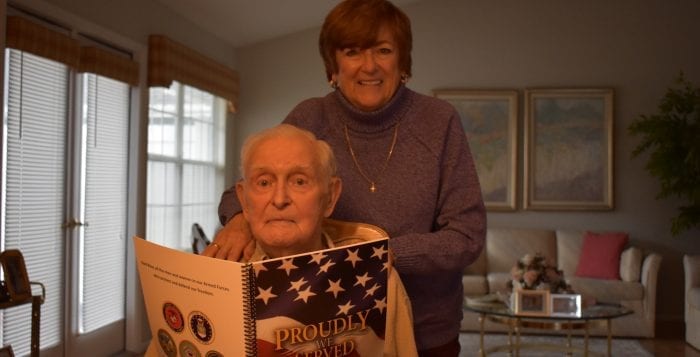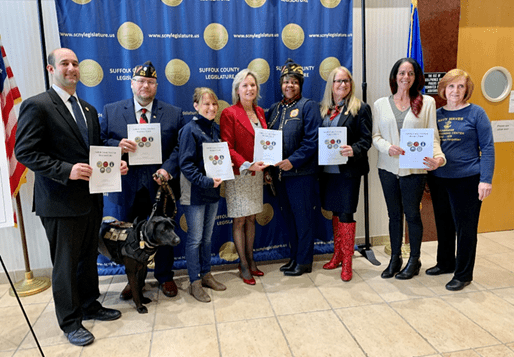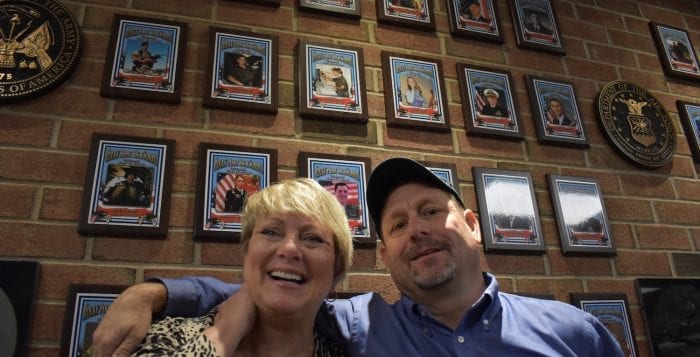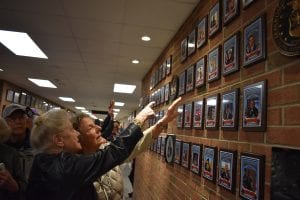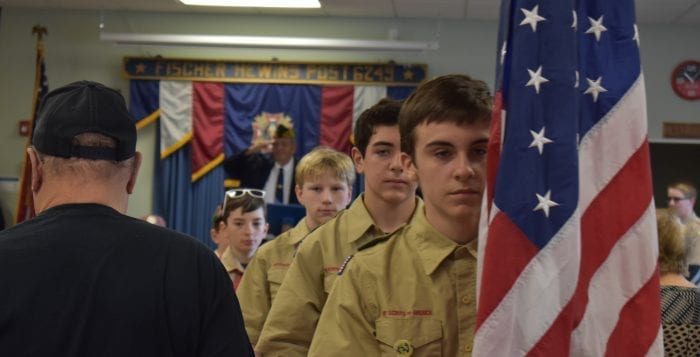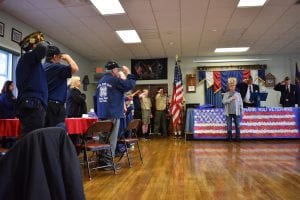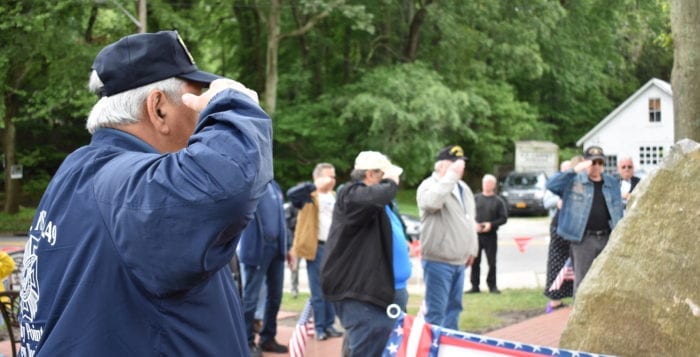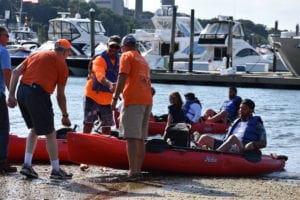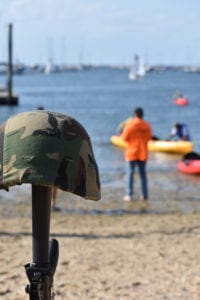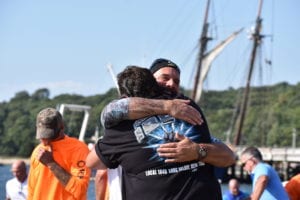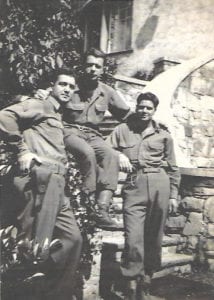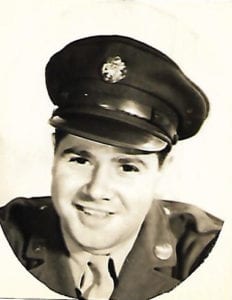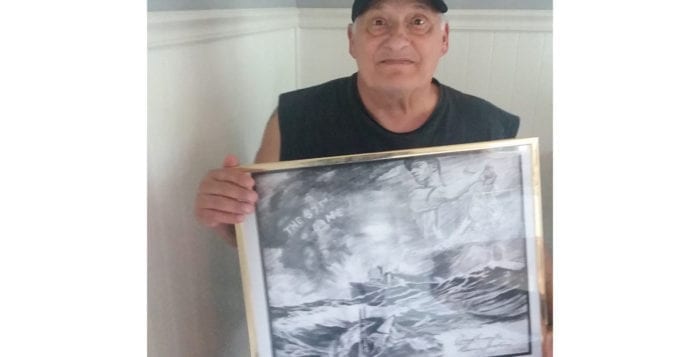It’s been little less than a year since Mary Ann Fox, of Leisure Glen in Ridge, finished her book of veterans in her own small community, titled “Proudly We Served.”
There are a few hundred homes in the 55-and-older gated community of Leisure Glen, and the stories of 63 veterans of that community lie within those pages, tales of both horror and heroism, of people who constantly and consistently told her they were proud to serve their country, hence the book’s title.
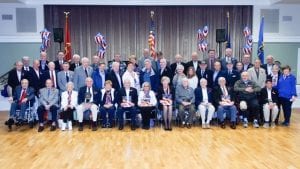
Photo from Fox
In the time since the book was officially released last April, 325 copies have been printed, and Fox has brought her books and those stories to local vets groups, schools, libraries and other civic-type groups.
But the time since her book’s release has also been heartbreaking. She has seen several of those men whose lives were memorialized in the pages of her book pass away.
On April 28, 2019, she held a ceremony in Leisure Glen that displayed her work to a packed room, including several elected officials. Just two months later, one of the vets, Andy Estrema, died. His story is one of the most harrowing described in the book. As a Marine during the Korean War, he fought in the Battle of Chosin Reservoir, where soldiers struggled against not only enemy machine guns but also a bitter cold that reached as low as -30 degrees Fahrenheit. He fought off waves of the enemy that struggled up the hill in the face of American machine gunners. He fought barefoot and lost all of his toes from frostbite. He was shot and injured during the battle in his lower back and only survived thanks to the men who fought alongside him.
Yet, Fox knew, this was the reason she wrote the book. The stories of those 63 veterans from Leisure Glen would, if not etched in stone, be forever contained in the glossy pages of her book. It would remain in the hands of the veterans’ families for as long as they could keep it.
“I felt very privileged,” she said. “They were sharing stories with me [that] some had not even shared with their family.”
She had been invited to Estrema’s military funeral, where she sat with the family as the ceremonial officers snapped the flag 13 times into a tight triangular fold. There, she said she could not help but tear up knowing the honor she was witnessing for the first time, firsthand.
Though it was the first military funeral she personally experienced, it wouldn’t be her last in the several months since her book was released.
That is the reality of the book she wrote, as she knows the stories contained within would outlast the men who told them. It has become a boon for the families whose loved ones have served, helping to prompt conversations about such events that they had rarely experienced before. Even during the writing process, Fox saw the effect that simply listening could have.
“They were waiting for someone to say, ‘I know you served in World war II …’ [I say] you served your country, tell me what you did, tell me your story and let me weave it into a story of your service to the country,” she said. “I say ‘tell me what you want me to write.’”
The Writing Process
Fox never had it in mind to write a book such as this. Before retiring, she owned a travel agency in Middle Island. She retired and moved to North Carolina in 1998. After 12 years, when her husband passed, she decided to move back to Long Island to be closer to her daughter, picking a spot quite close to the center of Leisure Glen.
It was 2018, Memorial Day, and American Legion Post 352 held a meeting at the gated community that would etch the idea in Fox’s mind.
“She heard our voices before our voices were stilled.”
— Jack Grady
The post commander said that one should get to know the stories of the veterans around them, because come Memorial Day next year, many would not be around any longer, their lives and stories taken by the march of time.
“He said, ‘Look at us, we get smaller in number every year, and we’re not going to be here forever.’” Fox recalled. “And then he finished by saying, ‘and you know what and nobody is going to know we were here.’”
It was the first time she had ever even thought about publishing a work such as that.
Before writing the book, she said, like most people, she had no real idea just what it was to have gone through war. Listening to their stories, she said she could tell just what kind of person it requires to go through that experience. Some stories hit her hard, such as Estrema’s. He had written everything out himself, what ended up being five pages in her book. During their conversation, she had to excuse herself.
“I went into the bathroom and I cried my heart out,” she said. “What they went through in this battle … he thoroughly believed that somewhere in battle, the blessed mother came to him — a very religious man, and he was until the day he died.”
With the massive number of interviews under her belt, with the piles and piles of notes on her desk, she quickly learned she needed somebody to help her unpack all the jargon and help her with grammar. That’s where Jack Grady came in, a 93-year-old World War II Army vet who also sees himself as an amateur military historian. Fox would drop off the pages to him, and then a day later he would call her back to give her the pages dotted with red pen marks and questions, asking her to go back and confirm some information with those fellow vets.
Before Fox, he said he had never been asked much about his own story. In his mind, it is mostly du to people’s desire to move on from such grave history.
“It was in the past,” Grady said. “The war was over, and of course we had Korea and, unfortunately, Vietnam, so World War II faded into [the] distance … it’s not that people were callous or anything, but they have their own concerns, and they don’t want to listen to these kinds of things unless somebody broaches the subject.”
The elder veteran looks at the book now as a testament, a means to forever keep their stories alive.
“We’re gone, almost,” he said. “She heard our voices before our voices were stilled.”
If Fox couldn’t talk to the veterans themselves, such as several who had recently passed, she received their stories from their wives. She got to know the tales of so many vets, and in writing the book, many of those family members finally got to hear the story of their service. After doing the first stint of a two-day interview with Korean War veteran James Dragone, his daughter followed Fox outside, quickly wrapping her arms around her with tears in her eyes. Fox thought, at first, she must have done something wrong, asked the wrong question or said the wrong thing, but then the daughter started thanking her, saying it was the first time she heard that story of her father.
“Her contribution to her community has been very significant — it was a labor of love you rarely see.”
— Jane Bonner
Each of the stories tells not just of a man, but a man within a community. It speaks of their children and grandchildren, of men like Daniel Testa, a Korean War vet’s amazing homemade mozzarella. Dragone’s story says Leisure Glen members knew him as the Flag Man because “for 20 years he raised and lowered our flags daily.”
Why had they not talked about it before to their families? Fox said in many cases it was the past, and these men wanted to move on.
“The World War II men — they saw so much they wanted to put it behind them — they were still young men — and start their life,” Fox said. “The Korean War veterans — they, I think, pretty much felt the same … The Vietnam veterans, they came home wounded, mentally, physically, but mostly mentally.”
Of the three wars covered in the book, the Vietnam War section is the shortest. She thinks that was due to the war they fought, and the things they must have witnessed during the fighting, and most simply they were proud to serve.
“There’s a Vietnam veteran in there who has three Purple Hearts, and when I introduced him at the ceremony, the one thing he asked me to do was not mention that,” she said. “They’re not looking for any glory.”
Ceremony and Reaction
At last year’s ceremony, which finally displayed more than a year’s worth of effort, a packed crowd listened to the introduction of all service members included in the book. The ceremony was joined by Town of Brookhaven Supervisor Ed Romaine (R) and Councilwoman Jane Bonner (R-Rocky Point), Suffolk County Legislator Sarah Anker (D-Mount Sinai), state Sen. Ken LaValle (R-Port Jefferson) and a representative from U.S. Rep. Lee Zeldin’s (R-NY1) office.
Little less than a year since then, Bonner said seeing all the work that went into such an event, and all the effort Fox put into the book, it was hard to come away not being dazzled by her efforts.
“I was just so impressed by her passion to undertake something like this,” she said. “Her contribution to her community has been very significant — it was a labor of love you rarely see.”
The book is a coil-bound glossy print, with a cover designed by her daughter. The ceremony’s program cover was designed by Carl Schmidt, a 95-year-old World War II veteran who was Fox’s first interview.
The event was officiated by Monsignor Charles Fink, himself a Vietnam veteran and the author of the famous poem “Bury Me with Soldiers.” After all names were called, Fink was recognized for his service, and once Fox said the Catholic priest was a Purple Heart recipient, all men who could stand stood, and all applauded.
Fox has taken her book nearly everywhere it has been requested, including Comsewogue and North Shore public libraries, the Tesla Science Center, the Long Island State Veterans Home and Albert G. Prodell Middle School for their annual Living History Day last May. She said she plans to attend this year’s event and hopes to bring with her a veteran from World War II, Korea and Vietnam. She also hopes she may be able to start a letter-writing campaign between the students and veterans.
Last year at the Rocky Point VFW Post 6249, she was also awarded a plaque for her work by the Town.
“They were sharing stories with me [that] some had not even shared with their family.”
— Mary Ann Fox
Joe Cognitore, the Rocky Point VFW post commander, called Fox “a very dedicated woman.” She came to one of the VFW’s meetings last year with several of the vets described in her book, and a few even decided to become members of Post 6249. He had even seen her at the Long Island Veterans home, handing out ornaments to some of those living there.
“I couldn’t thank her enough for all her work of preserving veterans’ history, especially the World War II veterans,” Cognitore said.
Before it was printed, two publishers were interested in the book, but the issue was it would have taken six to seven months for them to produce a finished product. For the veterans whose stories needed to be told, she knew she needed to print as soon as possible. Since April 2019, Estrema, Dragone and several other vets or their wives who provided the stories for the book have passed away. She knows she made the right choice, and she currently plans to keep it self-published with any additional printings.
Grady said Fox was one of the few people who could pull off a work like this, but of course, there are always more stories to tell.
“Most fellas don’t want to talk about those things, and it takes prodding to get the story done,” he said. “Mary Ann did 60, and I bet you she could do another 30 who didn’t answer the original ad.”
The VFW has asked if she could do a similar work for them, but she is still unsure since the men whom she wrote about in her book were from her own community, and it would be different venturing out to neighboring places. In Leisure Glen, newly arrived residents and others who did not originally respond to the first book requests have asked if they too could be included in later editions, and she said she is still trying to wrap her mind around what could be next.
For now, she’s simply looking to spread the stories of the veterans, her friends, the members of her community. She hopes other people look to the veterans in their communities and look to learn their stories as well.
“To be honest, before the book, I didn’t really grasp the concept of what these men went through,” she said. “You have to sit across from them, you have to see it in their eyes, and it just comes pouring out.”

